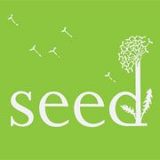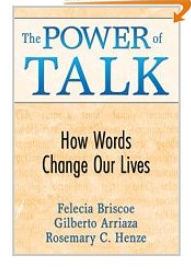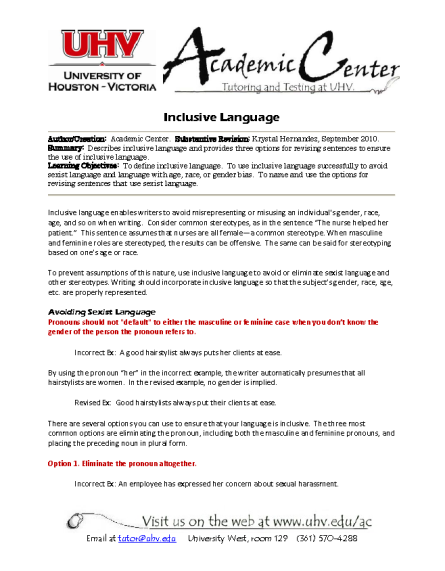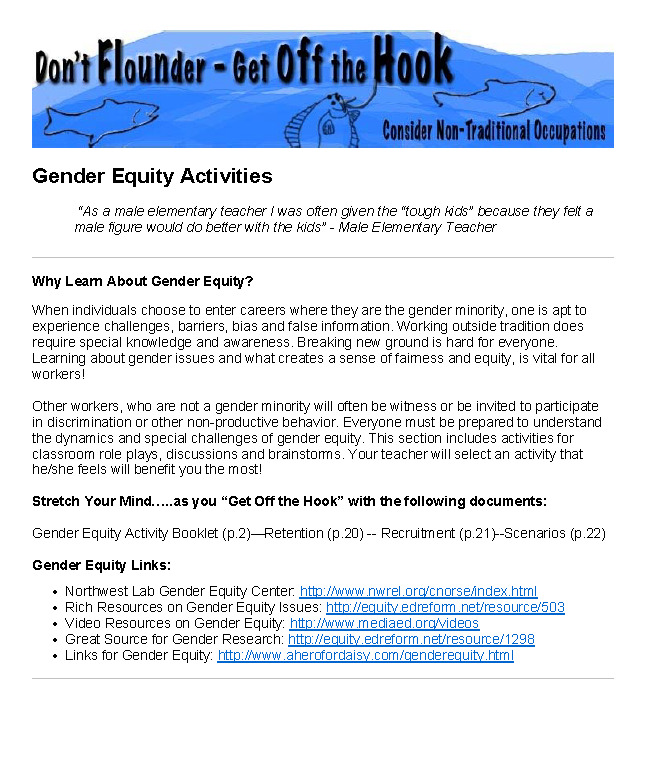|
IMPACT:
Educate, Engage, Empower--For Equity
"Our language can lift students to their highest potential or tear them down. It can help them build positive relationships or encourage discord and distrust. It shapes how students think and act and, ultimately, how they learn."
-Paula Denton
Author of
The
Power of Our Words: Teacher Language That Helps Children Learn
|
“How can we use the transformative power of language to advance educational equity and social justice?”
(Briscoe, Arriaza, & Henze, 2009, p. 25)
Words have the power to transform lives; engaging in discourse with others shapes our identities in ways that can constrain or facilitate full participation in society (Black & Burello, 2010). As educators focused on equity, we must continually reflect on our use of language - does it affirm others’ sense of self and create pathways to power and opportunity? We also must contend with the reality that even if we are successful at fostering positive communication in our classrooms, our students, fellow teachers, and families will encounter speech that attempts to disenfranchise and disempower them. How can we combat the deleterious impact of disempowering language and transform communication in our classrooms? First, we must become aware of damaging words and communication patterns and engage others in dialogue about language itself. At the same time, we must model and explicitly teach appropriate language use for specific contexts. As we do this, we can transform practices within our zones of influence and prepare students to contend with the expectations of the broader society.
Some instances of harmful speech are easy to identify – racist or homophobic slurs, for example – while others are more subtle. “It’s time to line up, boys and girls” may seem like a fairly innocuous statement. We do not imagine the speaker holding a sinister intent nor the students taking exception to it. Yet this single sentence and others like it can prime us to look for differences, thereby planting the “seeds of stereotyping” (Teaching Tolerance, 2005); in other words, we don’t want to
use differences in ways that set up or trigger limiting beliefs. At the same time, we don’t want to ignore social constructs like gender or race in the classroom. Rather, interrogating the historical meanings and effects of words is a key step toward emancipating ourselves and those around us. As we encounter and use language, particularly about students, families, and schools, we can ask the following questions (adapted from Brisco, Arriaza, & Henze, 2009):
- How are people classified?
- What (or whom) is being opposed or contrasted?
- Who or what is higher or lower in status?
- Who is the insider or outsider?
The answers to these questions can alert us to potentially disempowering speech. Beyond answering these questions for ourselves, asking the perspectives of those individuals to whom labels or descriptors apply is especially important if language appears damaging. How do students who withdraw from high school prior to completing the required course of instruction and receiving a diploma view the term
dropout? What about students labeled
emotionally disturbed? Do these students understand the sociocultural implications of the label? Would the child who did not bring in a completed homework assignment agree with the characterization of her behavior as
lazy? Understanding the meaning of labels from the perspective of those to whom the labels have been applied can lead to new understandings of the power of words.
Beyond the words or labels we use, language patterns must also be examined. Communication occurs in social situations that are always bounded by (often implicit) cultural rules of engagement (Goffman, 1997). Who is allowed to speak, and about what, and when? These structures produce and maintain social relations of power (Fairclough, 1989). Hand-raising is a common example; it is required of students in order to speak, but the teacher has the power to speak freely. There are also numerous other ways in which the rules for speaking curb participation: inducements to speak in “English only” or in “proper or standard English,” inflexible turn-taking procedures, lecturing, and so on. Furthermore, when these norms are not made explicit, students can be punished for failure to conform to rules they did not know existed.
Once we have become aware of damaging or disempowering words or patterns, we can engage others in transformation. Rather than policing others’ language, recognize others’ speech as “important entry points into conversation” (Chang & Conrad, 2008, p. 34). Banning words often results in lost opportunities to bring about more transformative change. First, begin by seeking further information: What did the speaker mean? At times, the effects of an utterance are out of step with the speaker’s intention. After seeking clarification, elicit others’ perceptions of the message or share your own. Finally, if the speaker is receptive, you might explore alternatives. When individuals can be made to understand the consequences and actual meaning of their utterances, sanctions may be unnecessary and restoration can occur (Braithwaite, 2002; Briscoe, Arriaza, & Henze, 2009).
Patterns or rules can also be transformed. Begin with what you notice about the implicit or explicit rules. For example, a high school science teacher reflecting on her instructional practice may share the following in a discussion with students: “I have noticed that the rule in this classroom seems to be that I can speak whenever I want, but when you want to speak, you must raise your hand. I am worried that this is not allowing everyone to fully participate in the conversation.” Then, invite discussion about what is possible. Use democratic deliberation to secure consent and commitment to standards, such as assigning a facilitator with particular authority that will be adhered to, then resolve conflicts through reflection on the original agreements (Braithwaite, 2002).
Helping your students recognize that hidden rules about language also exist outside of the classroom is an important way to assist them in navigating social expectations. For example, explaining dialects, including Standard English, and discussing their uses and limitations can help students understand what audiences expect and make their own choices about how to respond to these expectations. These conversations can bring together important lessons about language, power, and culture – including that there is no inherently “right” way to speak (Flynn, 2011).
Language should be “appreciated and celebrated as a resource” (Kozleski, Mulligan, & Hernandez-Saca, n.d., p. 1) to build connections between individuals in the learning community. In being more intentional about the words we use, the rules that structure our dialogic engagements, and our efforts to teach students the hidden rules of language, we can move ourselves and our students toward liberation and empowerment.
Have a question or comment about this article? Share it here! |
 The National Seeking Educational Equity and Diversity (SEED) Project on Inclusive Curriculum provides teachers an opportunity to rediscover their teacher-selves and to reflect on what gender-inclusive and multicultural curriculums might look like. The Project was founded by Peggy McIntosh, PhD., author of
White Privilege: Unpacking the Invisible Knapsack and has made inroads in a number of states. The National Seeking Educational Equity and Diversity (SEED) Project on Inclusive Curriculum provides teachers an opportunity to rediscover their teacher-selves and to reflect on what gender-inclusive and multicultural curriculums might look like. The Project was founded by Peggy McIntosh, PhD., author of
White Privilege: Unpacking the Invisible Knapsack and has made inroads in a number of states.
In Minnesota, SEED at Century College certainly upholds the philosophy of its parent group. The SEED participants at Century College make a nine-month commitment to exploring issues of equity and diversity concerning their students and colleagues. Participants are also provided with continuous feedback and support as they grapple with personal awareness of privilege and power that extend from the campus to the community. To the faculty and staff of Century College at Minnesota, SEED extends beyond the typical diversity workshop. This award-winning and unique faculty and staff development program has become a platform for Century College personnel to engage in intensive and continuous self-examination. This introspective engagement serves as a pathway for faculty and staff to become more adept at creating a safe and affirming environment for the colleagues they work with and for the students that they serve. |
 SEED cohorts have introduced several equity-related projects that they actively support on their campus. For example, SEED participants have teamed with Minnesota Gay, Lesbian, Bisexual, Transgender, Ally (GLBTA) Campus Alliance to offer trainings on campus. As part of their efforts to bring fairness and justice to the GLBT community, SEED participants have marketed the Speak Up! Campaign on campus to give individuals useful tools to help them confront situations where they may otherwise stand in silence. Rather than having their voices stifled, GLBT individuals and their allies learn strategies for responding to difficult situations in dignified ways. Members and affiliates of the SEED network testify that as a result of their affiliation, they listen to all voices, including their own, with greater attention. SEED cohorts have introduced several equity-related projects that they actively support on their campus. For example, SEED participants have teamed with Minnesota Gay, Lesbian, Bisexual, Transgender, Ally (GLBTA) Campus Alliance to offer trainings on campus. As part of their efforts to bring fairness and justice to the GLBT community, SEED participants have marketed the Speak Up! Campaign on campus to give individuals useful tools to help them confront situations where they may otherwise stand in silence. Rather than having their voices stifled, GLBT individuals and their allies learn strategies for responding to difficult situations in dignified ways. Members and affiliates of the SEED network testify that as a result of their affiliation, they listen to all voices, including their own, with greater attention.
As an equity assistance center, we champion and support the efforts of Seeking Educational Equity and Diversity (SEED) at Century College, Minnesota and at other locations throughout the country. At the heart of the SEED Project is the intent to become allies for those who experience subjugation by recognizing and challenging language that alienates and excludes. SEED Projects not only provide a network of support for oppressed individuals, but also work to dismantle the inequitable system that confines everyone.
|
|
Something to Read!
|
 The Power of Talk invites the reader to consider how adjusting everyday speech could transform schools and promote equitable learning environments for diverse groups of learners. The book presents case studies and vignettes of language use in schools and communities. Each chapter ends with engaging exercises that strengthen the reader’s awareness of the language they use daily; they can be used individually or for group discussion. For those interested in aligning their language with equitable practice, this book proves an excellent tool for personal development. This is a must-read for all teachers and school administrators.
The Power of Talk invites the reader to consider how adjusting everyday speech could transform schools and promote equitable learning environments for diverse groups of learners. The book presents case studies and vignettes of language use in schools and communities. Each chapter ends with engaging exercises that strengthen the reader’s awareness of the language they use daily; they can be used individually or for group discussion. For those interested in aligning their language with equitable practice, this book proves an excellent tool for personal development. This is a must-read for all teachers and school administrators.
|
Something to Use!
|
 In addition to being a tool for communication between humans, language is a cultural artifact that marks identity (Edwards, 2009) and as such it can be used to include or exclude certain groups in society. Becoming a culturally responsive communicator entails using inclusive language, or language that includes and empowers those around you. The following online resource was developed by the University of Houston – Victoria. It defines inclusive language and provides three options for revising communication in order to ensure inclusivity. At the end of the four page tool, the writers provide a 25-item exercise to assess inclusive language use. Please encourage a colleague to take the test and plan to discuss your responses. In addition to being a tool for communication between humans, language is a cultural artifact that marks identity (Edwards, 2009) and as such it can be used to include or exclude certain groups in society. Becoming a culturally responsive communicator entails using inclusive language, or language that includes and empowers those around you. The following online resource was developed by the University of Houston – Victoria. It defines inclusive language and provides three options for revising communication in order to ensure inclusivity. At the end of the four page tool, the writers provide a 25-item exercise to assess inclusive language use. Please encourage a colleague to take the test and plan to discuss your responses.
|
Something to Read!
|
 As teachers and administrators, we are constantly in need of tools that help us engage our students and colleagues in equity practices, particularly in the use of inclusive language. The following tool was developed by the Alaska Department of Education and Early Development, and is available on their website. It provides five engaging and interactive activities that could be used with students and teachers alike to increase sensitivity to gender equity and related issues. They include identifying what would be deemed as "men’s work" or "women’s work," a worksheet on sexual harassment, and an activity on identifying appropriate gender-inclusive words. As teachers and administrators, we are constantly in need of tools that help us engage our students and colleagues in equity practices, particularly in the use of inclusive language. The following tool was developed by the Alaska Department of Education and Early Development, and is available on their website. It provides five engaging and interactive activities that could be used with students and teachers alike to increase sensitivity to gender equity and related issues. They include identifying what would be deemed as "men’s work" or "women’s work," a worksheet on sexual harassment, and an activity on identifying appropriate gender-inclusive words.
|
|
Something to Watch!
|
Like many other social practices, language is constantly changing. In this video, an ESL teacher shares some simple changes we could make in our choice of words to create more gender inclusive speech. This video provides content that teachers can use to teach a simple vocabulary and grammar lesson about avoiding language that is not inclusive.
|
|
|
|
Reference List:
Educate:
Bigler, R. (2005). ‘Good morning boys and girls.’
Teaching Tolerance, 28. Retrieved November 19, 2012 from http://www.tolerance.org/magazine/number-28-fall-2005/good-morning-boys-and-girls
Black, W. & Burrello, L. (2010). Towards the cultivation of full membership in schools.
Journal of Values and Ethics in Educational Administration, 9(1), 1-8.
Braithwaite, J. (2002). Setting standards for restorative justice.
The Centre for Crime and Justice Studies, 42, 563-577.
Briscoe, F., Arriaza, G., & Henze, R. C. (2009).
The power of talk. Thousand Oaks, CA: Corwin.
Chang, K. & Conrad, R. (2008). Following children’s leads in conversations about race. In M. Pollock, Ed.,
Everyday anti-racism. New York, NY: The New Press.
Fairclough, N. (1989).
Language and power. New York, NY: Longman, Inc.
Flynn, J. E. (2011). The language of power: Beyond the grammar workbook.
English Journal, 100(4)
¸27-30.
Kozleski, E. B., Mulligan, E. & Hernandez-Saca, D. I. (2011). Language (policy) matters! Retrieved December 11, 2012 from http://connect.nwp.org/sites/default/files/file_file/language_policy_eric_brief_0.pdf
Teaching Tolerance (2005). 'Good morning boys and girls.’
Teaching Tolerance, 28. Retrieved December 11, 2012 from http://www.tolerance.org/magazine/number-28-fall-2005/good-morning-boys-and-girls
Disclaimer:
Great Lakes Equity Center is committed to the sharing of information regarding issues of equity in education. Reference in this newsletter to any specific publication, person, or idea is for the information and convenience of the public, and does not (necessarily) reflect the views and opinions of Great Lakes Equity Center. The contents of this newsletter were developed under a grant from the U.S. Department of Education. However, these contents do not necessarily represent the policy of the Department of Education, and you should not assume endorsement by the Federal Government. |
|
Only a Few Spaces Left!
Equity Leaders Institute
WHEN: February 20-21, 2013
WHERE: Indianapolis, IN
TOPIC: Advancing Educational Equity
|
|
|
|
Equity Spotlight
|
 |
|
Lorne Balmer spent several months as a graduate assistant at The Great Lakes Equity Center. Prior to joining the Equity Center staff, he graduated from Indiana University Kokomo with a degree in elementary education. During his time as an undergraduate, Lorne worked to understand the array of exceptionalities of all learners within the K-12 educational system through his fieldwork. His research as an undergraduate involved analyzing the Response to Intervention model used in Indiana. However, his research interests evolved as a result of his diverse practicum experiences, and Lorne became interested in understanding the ways in which all learners could be provided with equitable learning opportunities.
As a result of his shifted research interests, Lorne sought out and began a position at The Great Lakes Equity Center in May 2012. At the Center, he worked to research equity-related topics and provided educators, administrators, and equity-minded individuals with valuable information and resources through the Center’s publications. He was also integral to the development and dissemination of fact sheets on various topics such as engaging students in critical conversations through interactive read-alouds. Some of Lorne’s research areas included culturally responsive teaching practices, Universal Design for Learning, and the creation of effective school and family partnerships. Through his research, Lorne served as an advocate for educators by providing them with concrete strategies and resources outlining how to take equity-related concepts and integrate them into everyday professional practice.
Next year, Lorne will be returning to the classroom and will continue the promotion of equitable educational practices as a practitioner. Lorne will work to ensure all students in his classroom experience not only equal, but equitable educations. He will be greatly missed by the Great Lakes Equity Center staff, and we all wish him well as he continues his work in education.
|
|
Upcoming Events
|
Illinois
March 16-18, 2013
ASCD 2013 Annual Conference
Chicago, IL
Indiana
Jan. 22, 2013
Reading Textbook Caravan
Indpls, IN
Michigan
January 28, 2013
The University of Michigan
50 years Later: (R)evolution of the Dream
Ann Arbor, MI
Minnesota
Jan. 25, 2013
Minnesota Department of Education
Positive Change with Purpose, Data Practices, Discipline
North Mankato, MN
Ohio
March 6-8, 2013
Ohio School Board Association
Moving the Profession Forward: Preparing Teachers for a New World of Learning and Work- P – 16 Partnerships
Dublin, OH
Wisconsin
February 22, 2013
Western Wisconsin Education Conference
WWEC 2012: Educating the Whole Child
La Crosse, WI
National
April 27, 2013
Teaching Equity Conference
Des Monicas, WA
|
|
